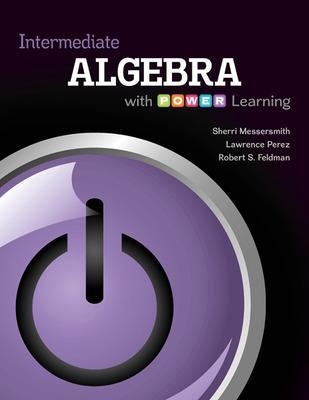
Intermediate Algebra with P.O.W.E.R. Learning
McGraw-Hill Professional (Verlag)
978-0-07-340627-5 (ISBN)
- Titel ist leider vergriffen;
keine Neuauflage - Artikel merken
What makes P.O.W.E.R. a unique tool for the classroom? A major challenge in developmental courses is that students at this level struggle with basic study skills and habits. Maybe this is one of their first college courses or perhaps they are adults returning to school after a long absence. Either way, many of the individuals taking this course don’t know how to be good students. Instructors often don’t have the time, the resources or the expertise to teach success skills AND the math concepts. The new team of Messersmith, Perez and Feldman offer a scientifically based approach to meet this challenge. The P.O.W.E.R. Learning Framework was developed by successful author, psychologist, student success instructor and researcher, Bob Feldman. It is a method of accomplishing any task using five simple and consistent steps. Prepare. Organize. Work. Evaluate. Rethink. This framework is integrated at every level of the text to help students successfully learn math concepts while at the same time developing habits that will serve them well throughout their college careers and in their daily lives. The Math
Mastering Concepts--With the textbook and Connect Math hosted by ALEKS, students can practice and master their understanding of algebraic concepts.Messersmith is rigorous enough to prepare students for the next level yet easy to read and understand. The exposition is written as if a professor is teaching in a lecture to be more accessible to students. The language is mathematically sound yet easy enough for students to understand.
Sherri Messersmith has been teaching at College of DuPage in Glen Ellyn, Illinois, since 1994. She has over 25 years of experience teaching many different courses from developmental mathematics through calculus. She earned a bachelor of science degree in the teaching of mathematics at the University of Illinois at Urbana-Champaign and went on to teach at the high level for two years. Sherri returned to UIUC and earned a master of science in applied mathematics and stayed on at the university to teach and coordinate large sections of undergraduate math courses. Sherri has authored several textbook, and she has also appeared in videos accompanying several McGraw-Hill texts. Sherri lives outside of Chicago with her husband, Phil, and their daughters, Alex and Cailen. In her precious free time, she likes to read, play the guitar, and travel -- the manuscripts for this and her previous books have accompanied her from Spain to Greece and many points in between. Bob Feldman still remembers those moments of being overwhelmed when he started college at Wesleyan University. I wondered whether I was up to the challenges that faced me, he recalls, andalthough I never would have admitted it at the timeI really had no idea what it took to be successful at college. That experience, along with his encounters with many students during his own teaching career, led to a life-long interest in helping students navigate the critical transition that they face at the start of their own college careers. Professor Feldman, who went on to receive a doctorate in psychology from the University of WisconsinMadison, is now Deputy Chancellor and Professor of Psychological and Brain Sciences at the University of Massachusetts Amherst. He is founding director of POWER Up for Student Success, the first-year experience course for incoming students. Professor Feldmans proudest professional accomplishment is winning the College Outstanding Teaching Award at UMass. He also has been named a Hewlett Teaching Fellow and was Senior Online Instruction Fellow. He has taught courses at Mount Holyoke College, Wesleyan University, and Virginia Commonwealth University. Professor Feldman is a Fellow of the American Psychological Association, the Association for Psychological Science, and the American Association for the Advancement of Science. He is a winner of a Fulbright Senior Research Scholar and Lecturer award and has written over 200 scientific articles, book chapters, and books. His books, some of which have been translated into Spanish, French, Portuguese, Dutch, Japanese, and Chinese, include Improving the First Year of College: Research and Practice; Understanding Psychology, 12/e; and Development Across the Life Span, 7/e. His research interests encompass the study of honesty and truthfulness in everyday life, development of nonverbal behavior in children, and the social psychology of education. His research has been supported by grants from the National Institute of Mental Health and the National Institute on Disabilities and Rehabilitation Research. With the last of his three children completing college, Professor Feldman occupies his spare time with pretty decent cooking and earnest, but admittedly unpolished, piano playing. He also loves to travel. He lives with his wife, who is an educational psychologist, in a home overlooking the Holyoke mountain range in western Massachusetts.
Intermediate Algebra with P.O.W.E.R. Learning, First EditionChapter 1: Real NumbersSection 1.1Set of NumbersSection 1.2Operations on Real NumbersSection 1.3Order of OperationsSection 1.4Algebraic Expressions and Properties of Real NumbersChapter SummaryChapter ReviewChapter TestChapter 2: Linear Equations in One VariableSection 2.1Linear Equations in One VariableSection 2.2Formulas and PercentSection 2.3Applications of Linear EquationsSection 2.4Applications Involving PercentsSection 2.5More Applications of Linear EquationsChapter SummaryChapter ReviewChapter TestCumulative Review for Chapters 1 and 2Chapter 3: Linear Inequalities and Absolute ValueSection 3.1Linear Inequalities in One VariableSection 3.2Compound Inequalities in One VariableSection 3.3Absolute Value Equations and InequalitiesChapter SummaryChapter ReviewChapter TestCumulative Review for Chapters 1 – 3 Chapter 4: Linear Equations in Two VariablesSection 4.1Introduction to Linear Equations in Two VariablesSection 4.2Slope of a Line and Slope-Intercept FormSection 4.3Writing an Equation of a LineSection 4.4Linear and Compound Linear Inequalities in Two VariablesSection 4.5Introduction to FunctionsChapter SummaryChapter ReviewChapter TestCumulative Review for Chapters 1 – 4 Chapter 5: Solving Systems of Linear EquationsSection 5.1Solving Systems of Linear Equations in Two VariablesSection 5.2Solving Systems of Linear Equations in Three VariablesSection 5.3Application of Systems of Linear EquationsSection 5.4Solving Systems of Linear Equations Using MatricesChapter SummaryChapter ReviewChapter TestCumulative Review for Chapters 1 – 5 Chapter 6: Polynomials and Polynomial FunctionsSection 6.1The Rules of ExponentsSection 6.2More on Exponents and Scientific NotationSection 6.3Addition and Subtraction of Polynomials and Polynomial FunctionsSection 6.4Multiplication of Polynomials and Polynomial FunctionsSection 6.5Division of Polynomialsand Polynomial FunctionsChapter SummaryChapter ReviewChapter TestCumulative Review for Chapters 1 – 6 Chapter 7: Factoring PolynomialsSection 7.1The Greatest Common Factor and Factoring by GroupingSection 7.2Factoring Trinomials Section 7.3Special Factoring TechniquesPutting It All TogetherSection 7.4Solving Quadratic Equations by Factoring and ApplicationsChapter SummaryChapter ReviewChapter TestCumulative Review for Chapters 1 – 7 Chapter 8: Rational Expressions, Equations, and FunctionsSection 8.1Simplifying, Multiplying, and Dividing Rational Expressions and FunctionsSection 8.2Adding and Subtracting Rational ExpressionsSection 8.3Simplifying Complex FractionsSection 8.4Solving Rational EquationsPutting It All TogetherSection 8.5Application of Rational EquationsSection 8.6VariationChapter SummaryChapter ReviewChapter TestCumulative Review for Chapters 1 – 8 Chapter 9: Radicals and Rational ExponentsSection 9.1Radical Expressions and FunctionsSection 9.2Rational ExponentsSection 9.3Simplifying Expressions Containing Square Roots Section 9.4Simplifying Expressions Containing Higher RootsSection 9.5Adding, Subtracting, and Multiplying RadicalsSection 9.6Dividing RadicalsPutting It All TogetherSection 9.7Solving Radical EquationsSection 9.8Complex NumbersChapter SummaryChapter ReviewChapter TestCumulative Review for Chapters 1 – 9 Chapter 10: Quadratic Equations and FunctionsSection 10.1The Square Root Property and Completing the SquareSection 10.2The Quadratic FormulaPutting It All TogetherSection 10.3Equations in Quadratic FormSection 10.4Formulas and ApplicationsSection 10.5Quadratic Functions and their GraphsSection 10.6Application of Quadratic Functions and Graphing Other ParabolasSection 10.7Quadratic and Rational InequalitiesChapter SummaryChapter ReviewChapter TestCumulative Review for Chapters 1 – 10 Chapter 11: Exponential and Logarithmic FunctionsSection 11.1Inverse FunctionsSection 11.2Exponential FunctionsSection 11.3Logarithmic FunctionsSection 11.4Properties of LogarithmsSection 11.5Common and Natural Logarithms and Change of BaseSection 11.6Solving Exponential and Logarithmic EquationsChapter SummaryChapter ReviewChapter TestCumulative Review for Chapters 1 – 11 Chapter 12: Nonlinear Functions, Conic Sections, and Nonlinear SystemsSection 12.1Graphs of Other Useful Functions Section 12.2The CircleSection 12.3The EllipseSection 12.4The HyperbolaPutting It All TogetherSection 12.5Nonlinear Systems of EquationsSections 12.6Second-Degree Inequalities and System of InequalitiesChapter SummaryChapter ReviewChapter TestCumulative Review for Chapters 1 – 12 AppendixSection AReview of FractionsSection BGeometry ReviewSection C Synthetic Division and the Remainder TheoremSection DDeterminants and Cramer’s Rule
| Erscheint lt. Verlag | 16.2.2013 |
|---|---|
| Zusatzinfo | 1159 Illustrations, unspecified |
| Sprache | englisch |
| Maße | 218 x 277 mm |
| Gewicht | 1901 g |
| Themenwelt | Mathematik / Informatik ► Mathematik ► Algebra |
| ISBN-10 | 0-07-340627-9 / 0073406279 |
| ISBN-13 | 978-0-07-340627-5 / 9780073406275 |
| Zustand | Neuware |
| Haben Sie eine Frage zum Produkt? |
aus dem Bereich



